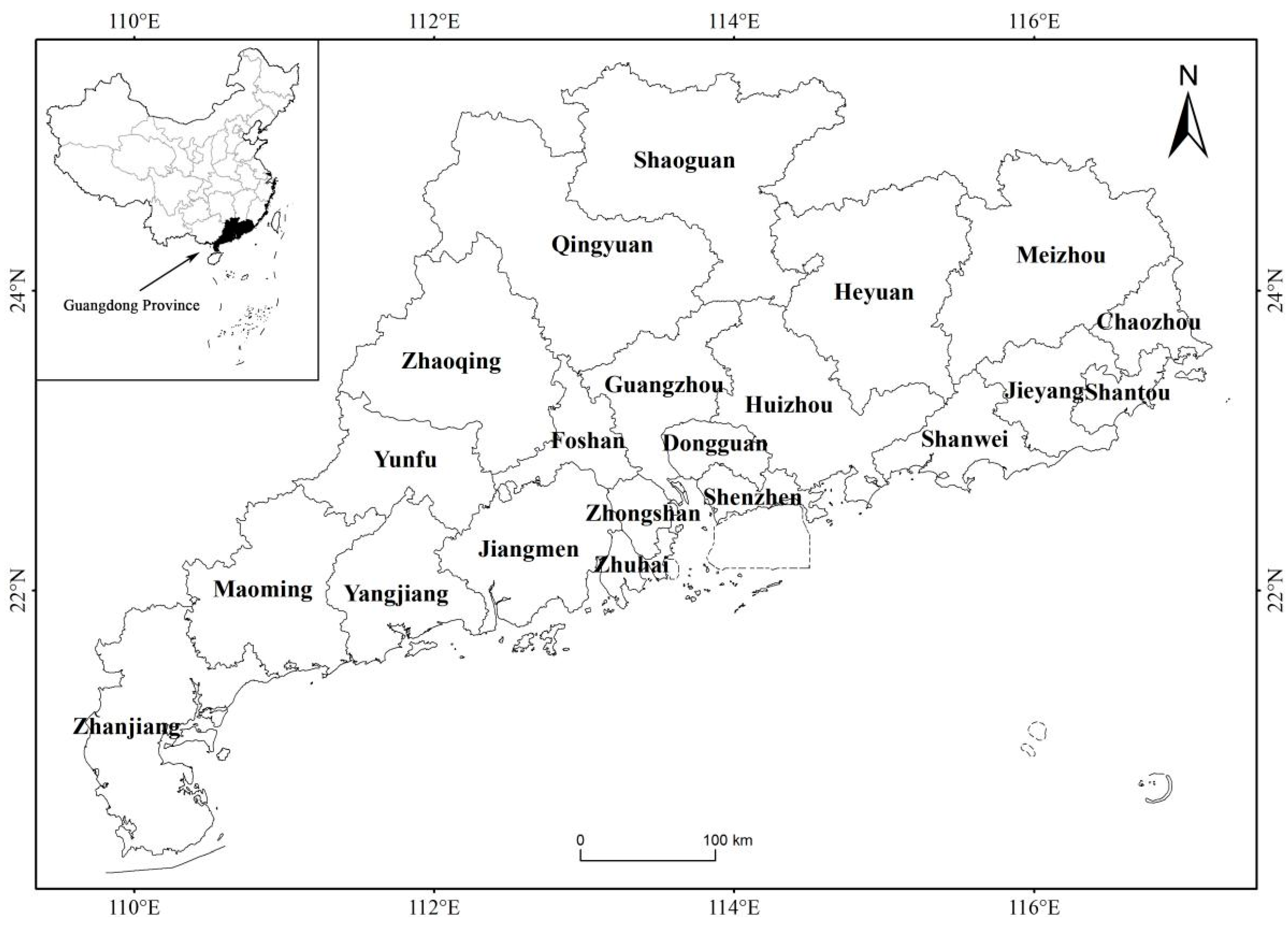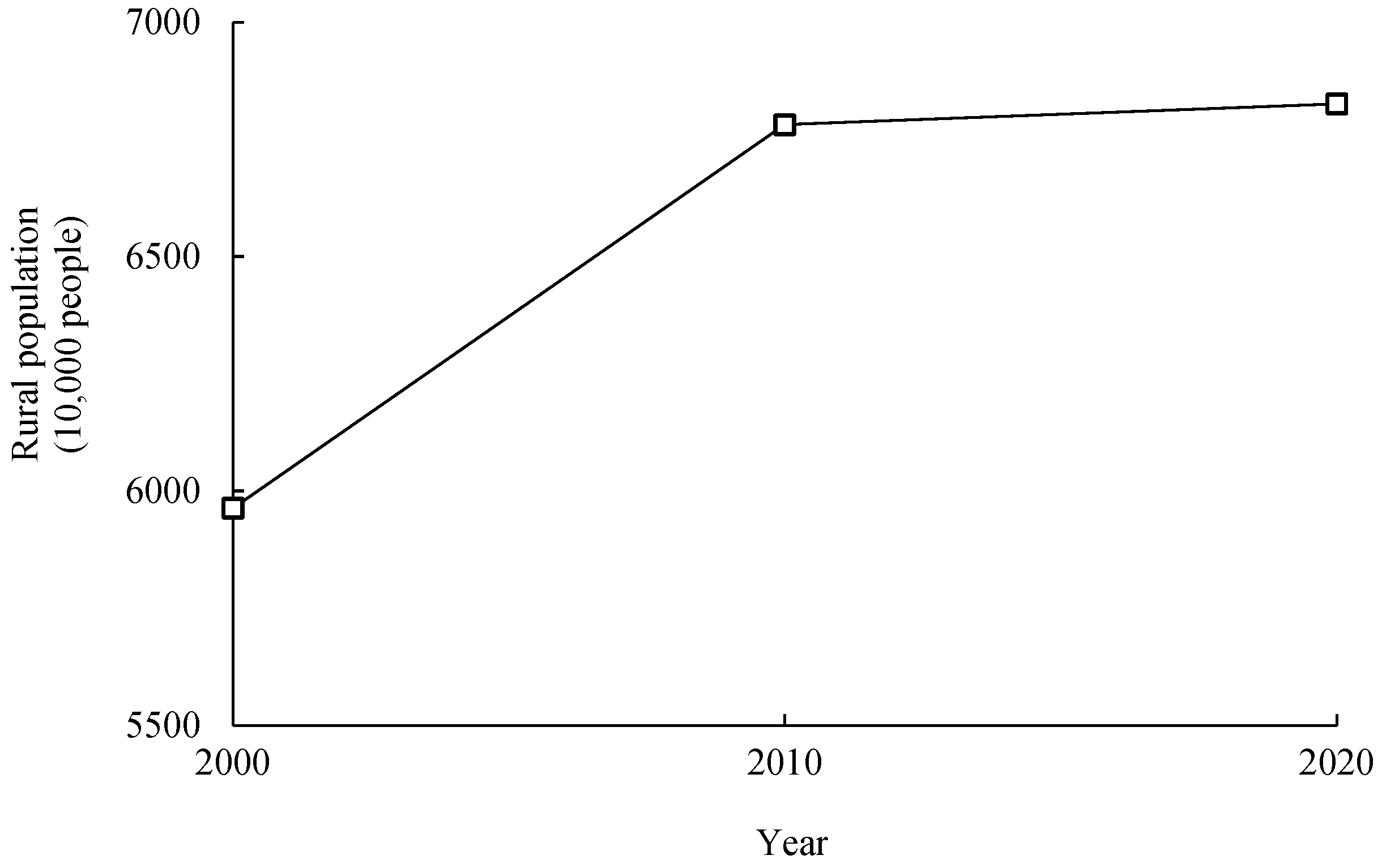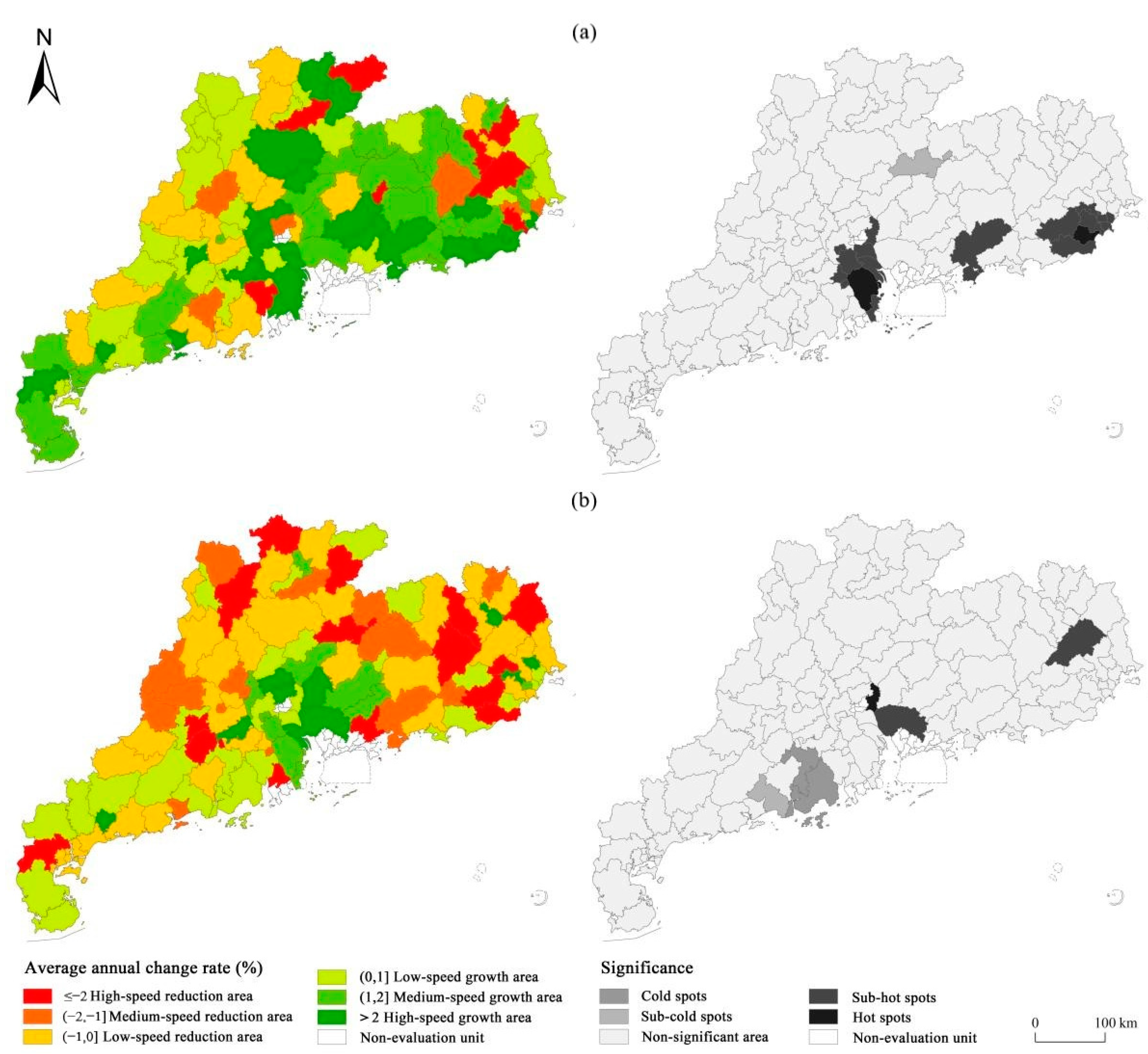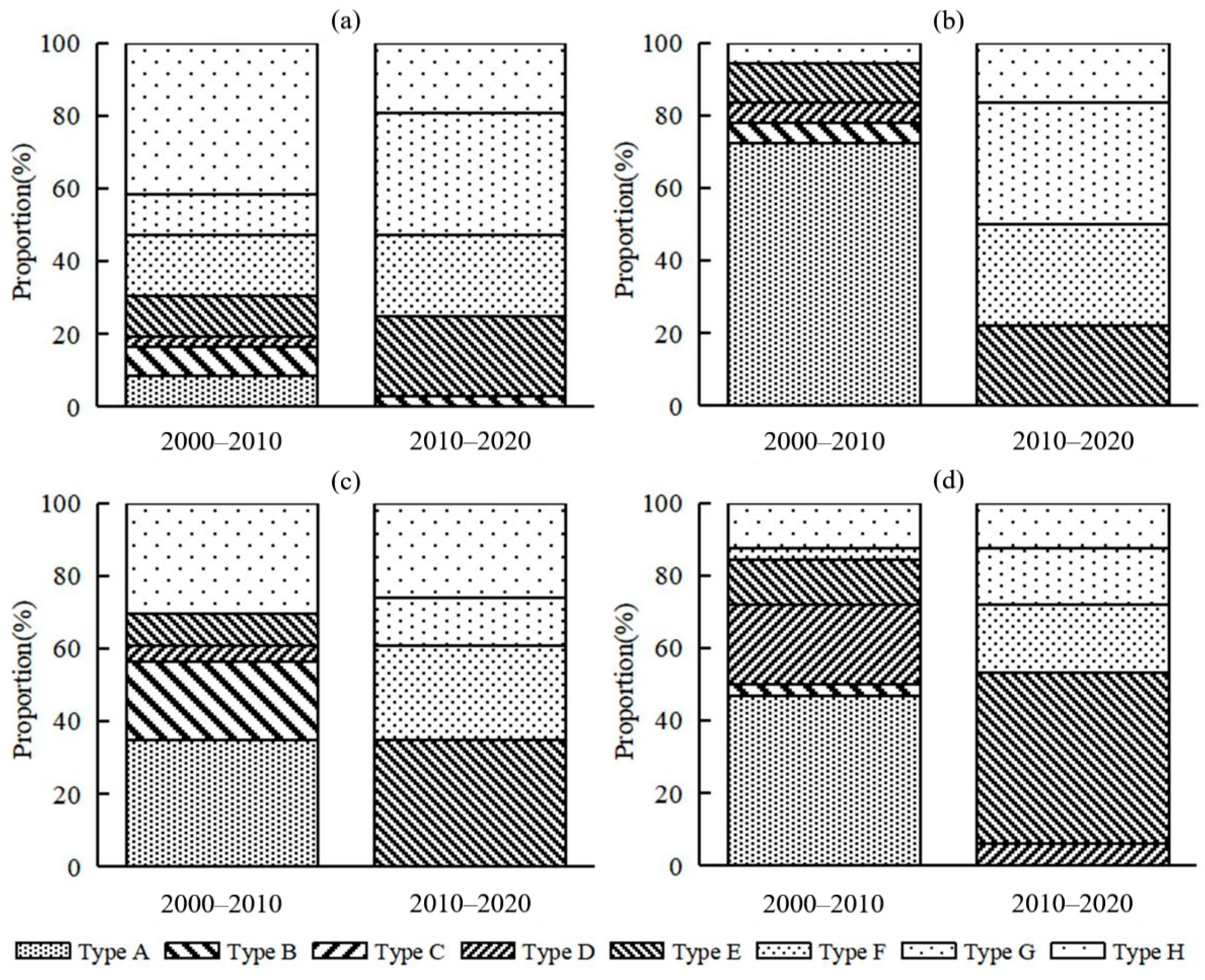Spatio-Temporal Coupling Relationship between Rural Population and Cultivated Land Changes at the County Level in Guangdong Province
Abstract
1. Introduction
2. Study Area, Data and Methodology
2.1. Study Area
2.2. Data Sources and Pre-Processing
2.3. Research Methods
2.3.1. Measurement of Rural Population and Cultivated Land Changes
2.3.2. Measurement of Coupling Relationship between Rural Population Change and Cultivated Land Changes
2.3.3. Hotspot Analysis
3. Results
3.1. Spatio-Temporal Characteristics of Rural Population Change
3.2. Spatio-Temporal Characteristics of Cultivated Land Area Change
3.3. Spatio-Temporal Characteristics of the Change in per Capita Cultivated Land Area
3.4. Coupling Relationship between Rural Population and Cultivated Land Change
3.5. Driving Factors of the Coupling Relationship between Rural Population and Cultivated Land Change
4. Discussion
4.1. Changes in Rural Population and Cultivated Land Use in Guangdong Province
4.2. Recommendations
4.3. Deficiencies and Prospects
5. Conclusions
Author Contributions
Funding
Institutional Review Board Statement
Informed Consent Statement
Data Availability Statement
Acknowledgments
Conflicts of Interest
References
- Liu, Y.; Li, Y. Spatio-temporal Coupling Relationship between Cultivated Land and Agricultural Labor Changes at County Level in China. Resour. Sci. 2010, 65, 1602–1612. [Google Scholar]
- United Nations. Transforming Our World: The 2030 Agenda for Sustainable Development; United Nations: New York, NY, USA, 2015. [Google Scholar]
- Zhang, Z. Sustainable Land Use Goals, Challenges and Countermeasures in China for SDGs. China Land Sci. 2019, 33, 48–55. [Google Scholar]
- Opinions of the CPC Central Committee and the State Council on Comprehensively Promoting the Key Work of Rural Revitalization in 2002. The People’s Daily, 23 February 2022.
- Huang, J.; Li, Y.; Xu, Q.; Shu, T.; Wang, Q.; Wang, M. Spatio-temporal Coupling Relationship between Rural Population and Cultivated Land Change in Karst Trough Valley Area. Res. Soil Water Conserv. 2021, 28, 281–290. [Google Scholar]
- Zhang, G.; Liu, J.; Zhang, Z. Spatial-temporal Changes of Cropland in China for the Past 10 Years Based on Remote Sensing. Acta Geogr. Sin. 2003, 58, 323–332. [Google Scholar]
- Wu, D.; Liu, Y.; Dong, Y.; Liu, H.; Ni, S. Analysis on the Spatial-temporal Changes of Cultivated Land and Their Driving Forces in Zhuhai. Trop. Geogr. 2009, 29, 472–476, 482. [Google Scholar]
- Hu, Q.; Wu, W.; Xiang, M.; Chen, D.; Long, Y.; Song, Q.; Liu, Y.; Lu, M.; Yu, Q. Spatio-temporal Changes in Global Cultivated Land over 2000–2010. Sci. Agric. Sin. 2018, 51, 1091–1105. [Google Scholar]
- Li, X. Change of Arable Land Area in China during the Past 20 Years and its Policy Implications. J. Nat. Res. 1999, 14, 329–333. [Google Scholar]
- Wang, W.; Cao, Y.; Su, R.; Song, L.; Zhuang, Y.; Zhou, W. Driving Forces of Cultivated Land Change in China. Chin. J. Agric. Res. Reg. Plan. 2020, 41, 21–30. [Google Scholar]
- Li, D.; Zhou, J.; Zhan, D. Spatial and Temporal Changes and Driving Factors of Cultivated Land in Heilongjiang Province. Sci. Geogr. Sin. 2021, 4, 1266–1275. [Google Scholar]
- Verburg, P.; Steeg, J.; Veldkamp, A.; Willemen, L. From Land Cover Change to Land Function Dynamics: A Major Challenge to Improve Land Characterization. J. Environ. Manag. 2009, 90, 1327–1335. [Google Scholar] [CrossRef] [PubMed]
- Song, X.; Ouyang, Z. Connotation of Multifunctional Cultivated Land and its Implications for Cultivated Land Protection. Prog. Geogr. 2012, 3, 859–868. [Google Scholar]
- Wu, D.; Liu, Y.; Zhang, X.; He, Y. Analysis of Cultivated Land Function Evaluation in Guangzhou City from 1990 to 2014. Chin. J. Agric. Resour. Reg. Plan. 2019, 40, 64–72. [Google Scholar]
- Grainger, A. National Land Use Morphology: Patterns and Possibilities. Geography 1995, 80, 235–245. [Google Scholar]
- Long, H.; Li, X. Cultivated-land Transition and Land Consolidation and Reclamation in China: Research Progress and Frame. Prog. Geogr. 2006, 25, 67–76. [Google Scholar]
- Song, X.; Wu, Z.; Ouyang, Y. Route of Cultivated Land Transition Research. Geogr. Res. 2014, 33, 403–413. [Google Scholar]
- Chen, Y.; Li, X. Structural Change of Agricultural Land Use Intensity and its Regional Disparity in China. Acta Geogr. Sin. 2009, 64, 469–478. [Google Scholar] [CrossRef]
- Ma, C.; Liu, L. Cultivated Land Use Intensity in Regions with Different Economic Development Levels. Res. Sci. 2019, 41, 2296–2306. [Google Scholar] [CrossRef]
- Wang, G.; Liu, Y.; Chen, Y. Dynamic Trends and Driving Forces of Land-use Intensification in the Cultivated Land of China. Acta Geogr. Sin. 2014, 69, 907–915. [Google Scholar] [CrossRef]
- Liu, Y.; Liu, Y.; Zhang, Y. Prediction of Gross Arable Land Based on Grey-Markov Model. Geomat. Inf. Sci. Wuhan Univ. 2004, 29, 575–579, 596. [Google Scholar]
- Li, L.; Wu, D.; Wang, F.; Liu, Y.; Liu, Y.; Qian, L. Prediction and Trade-off Analysis of Ecosystem Service Value in the Rapidly Urbanizing Foshan City of China: A Case Study. Acta Ecol. Sin. 2020, 40, 9023–9036. [Google Scholar]
- Yu, H.; Zeng, S.; Wang, Q.; Dai, J.; Bian, Z.; Chen, F. Forecast on China’s Cultivated Land Protection Baseline in the New Era by Multi-scenario Simulations. Res. Sci. 2021, 43, 1222–1233. [Google Scholar]
- Zhang, Y.; Feng, Y.; Wang, F.; Chen, Z.; Li, X. Spatiotemporal Differentiation and Driving Mechanism of Cultivated Land Non- grain Conversion in Guangdong Province. Res. Sci. 2022, 4, 480–493. [Google Scholar] [CrossRef]
- Padoch, C.; Sunderland, T. Managing Landscapes for Greater Food Security and Improved Livelihoods. Unasylva 2013, 64, 3–13. [Google Scholar]
- Li, Y.; Zhao, B.; Huang, A.; Xiong, B.; Song, C. Characteristics and Driving Forces of Non-Grain Production of Cultivated Land from the Perspective of Food Security. Sustainability 2021, 13, 14047. [Google Scholar] [CrossRef]
- Cai, Y. The Mechanisms of Cropland Conservation in Chinese Rural Transformation. Sci. Geogr. Sin. 2001, 21, 1–6. [Google Scholar]
- Baylis, K.; Peplow, S.; Rausser, G.; Simon, L. Agri-environmental Policies in the EU and United States: A Comparison. Ecol. Econ. 2007, 65, 753–764. [Google Scholar] [CrossRef]
- Zhou, W.; Shen, L.; Shi, J.; Ma, P. Research on Cultivated Land Protection Compensation Based on compulsory Cultivated Land. J. Arid Land Res. Environ. 2022, 36, 1–9. [Google Scholar]
- Li, S.; Li, X. Economic Characteristics and the Mechanism of Cultivated Land Marginalization in Mountainous Area of China. Acta Geogr. Sin. 2018, 73, 803–817. [Google Scholar]
- Feng, Z.; Li, F.; Yang, Y.; Li, P. The Past, Present, and Future of Population Geographyin China: Progress, Challenges and Opportunities. J. Geogr. Sci. 2017, 27, 925–942. [Google Scholar] [CrossRef]
- Qi, X.; Zhu, Y.; Zhou, Y. A “Double-pull” Model of Rural Labor Migration and its in Situ Urbanization Effect: Cases Studies of Three Coastal Area in Southeast China. Sci. Geogr. Sin. 2012, 32, 25–30. [Google Scholar]
- Zhou, Z. The Hollow-out of China’s Rural Population and its Challenges. Popul. Res. 2008, 32, 45–52. [Google Scholar] [CrossRef]
- Liu, Y.; Liu, Y.; Zhai, R. Geographical Research and Optimizing Practice of Rural Hollowing in China. Acta Geogr. Sin. 2009, 64, 1193–1202. [Google Scholar]
- Jiang, A.; Liu, C. The Role of Rural Elites in Traditional Villages Under the Background of “over-thinning” of Rural Area: A Case Study of E Village in Shengjiaba Township, Southwest Hubei Province. J. South Cent. Univ. Natl. (Humanit. Soc. Sci. Ed.) 2019, 39, 33–37. [Google Scholar]
- Long, D.; Li, T.; Miao, Y.; Liu, C.; Li, X.; Meng, H. Spatio-temporal Characteristics and Impacting Factors of Non-agriculturalization of China’s Rural Population. Prog. Geogr. 2014, 33, 517–530. [Google Scholar]
- Chen, X.; Wu, C.; Fang, M. Coordination of Industry, Population and Land Deagriculturalization during the Rapid Process of Urbanization in Zhejiang Province. China Popul. Res. Environ. 2014, 24, 129–134. [Google Scholar]
- Chen, X.; Zhu, S.; Kong, X.; Chen, C. Dynamic and Static Characteristics of Spatiotemporal Coupling Among Rural Population, Land, and Industry in Hubei Province. Chin. J. Agric. Res. Reg. Plan. 2021, 42, 31–38. [Google Scholar]
- Liu, Y.; Zhou, Y.; Li, Y. Rural Regional System and Rural Revitalization Strategy in China. Acta Geogr. Sin. 2019, 74, 2511–2528. [Google Scholar]
- Wu, X.; Li, T. Research on Coordinated Development of Rural Population-Economy-Land Spatial Agglomeration and Coupling—Takes Henan Province as An Example. Hubei Soc. Sci. 2019, 6, 61–69. [Google Scholar]
- Li, J.; Yang, Y.; Jiang, N. County-rural Transformation Development from Viewpoint of “Population-Land-Industry” in Beijing-Tianjin-Hebei Region under the Background of Rapid Urbanization. Sustainability 2017, 9, 1637. [Google Scholar] [CrossRef]
- Yang, R.; Liu, Y.; Long, H. The Study on Non-agricultural Transformation Co-evolution Characteristics of “Population-Land-Industry”: Case Study of the Bohai Rim in China. Geogr. Res. 2015, 34, 475–486. [Google Scholar]
- Liu, J.; Liu, Y.; Li, Y.; Hu, Y. Coupling Analysis of Rural Residential Land and Rural Population in China during 2007-2015. J. Nat. Res. 2018, 33, 1861–1871. [Google Scholar]
- Liu, Y.; Yang, Q.; He, X. Coupling Relationship of Rural Settlements and Rural Resident Population Change of Chongqing. Trans. Chin. Soc. Agric. Eng. 2019, 35, 266–274. [Google Scholar]
- Cao, X.; Chen, J.; Chen, L.; Liao, A.; Sun, F.; Li, Y.; Li, L.; Lin, Z.; Pang, Z.; Chen, J.; et al. Preliminary analysis of spatiotemporal pattern of global land surface water. Sci. China Earth Sci. 2014, 57, 2330–2339. [Google Scholar] [CrossRef]
- Wu, Y.; Liu, Y.; Li, Y. Spatio-temporal Coupling of Demographic-Landscape Urbanization and its Driving Forces in China. Acta Geogr. Sin. 2018, 73, 1865–1879. [Google Scholar]
- Liu, Y.; Li, Y. Revitalize the World’s Countryside. Nature 2017, 548, 275–277. [Google Scholar] [CrossRef]
- Liu, Y.; Yang, Y.; Li, Y.; Li, J. Conversion from Rural Settlements and Arable Land Under Rapid Urbanization in Beijing during 1985-2010. J. Rural. Stud. 2017, 51, 141–150. [Google Scholar] [CrossRef]
- Liu, Z.; Liu, L.; Sun, L.; Zhao, X.; Hu, Y. Spatial-temporal Patterns and Driving Forces of Land Use Change in Guangdong Province. J. Agric. Sci. 2018, 46, 253–260. [Google Scholar]
- Liu, G.; Wang, H.; Lu, D.; Xie, Q. Impact of Rural Out-migration and Endowments Dependency on Agriculture Land Use Intensity. Chin. J. Agric. Res. Reg. Plan. 2021, 42, 58–65. [Google Scholar]
- Lu, D. Planning: Towards Transformation and Revitalization: Exploration of the “Three Old” Transformation Planning. Urban Dev. Stud. 2013, 20, 43–49. [Google Scholar]








| Coupling Relationship Types | Quantity of Research Units | Proportion of the Quantity of Counties in the Study Area (%) | |||
|---|---|---|---|---|---|
| 2000–2010 | 2010–2020 | 2000–2010 | 2010–2020 | ||
| Coordinated development types | B | 10 | 1 | 9.17 | 0.92 |
| C | 0 | 0 | 0.00 | 0.00 | |
| D | 10 | 2 | 9.17 | 1.83 | |
| E | 12 | 35 | 11.01 | 32.11 | |
| Total | 32 | 38 | 29.36 | 34.86 | |
| Maladjusted development types | A | 39 | 0 | 35.78 | 0.00 |
| F | 7 | 25 | 6.42 | 22.94 | |
| G | 4 | 26 | 3.67 | 23.85 | |
| H | 27 | 20 | 24.77 | 18.35 | |
| Total | 77 | 71 | 70.64 | 65.14 | |
Publisher’s Note: MDPI stays neutral with regard to jurisdictional claims in published maps and institutional affiliations. |
© 2022 by the authors. Licensee MDPI, Basel, Switzerland. This article is an open access article distributed under the terms and conditions of the Creative Commons Attribution (CC BY) license (https://creativecommons.org/licenses/by/4.0/).
Share and Cite
Ma, P.-F.; Wu, D.-F.; Lin, T.; Wu, Z.-J.; Li, Z.-C.; Liang, Y.-X.; Zhang, Y.-C.; Lai, H.-M. Spatio-Temporal Coupling Relationship between Rural Population and Cultivated Land Changes at the County Level in Guangdong Province. Sustainability 2022, 14, 14929. https://doi.org/10.3390/su142214929
Ma P-F, Wu D-F, Lin T, Wu Z-J, Li Z-C, Liang Y-X, Zhang Y-C, Lai H-M. Spatio-Temporal Coupling Relationship between Rural Population and Cultivated Land Changes at the County Level in Guangdong Province. Sustainability. 2022; 14(22):14929. https://doi.org/10.3390/su142214929
Chicago/Turabian StyleMa, Pei-Fang, Da-Fang Wu, Tong Lin, Zhao-Jun Wu, Zhao-Cheng Li, Yi-Xuan Liang, Yu-Cheng Zhang, and Huan-Ming Lai. 2022. "Spatio-Temporal Coupling Relationship between Rural Population and Cultivated Land Changes at the County Level in Guangdong Province" Sustainability 14, no. 22: 14929. https://doi.org/10.3390/su142214929
APA StyleMa, P.-F., Wu, D.-F., Lin, T., Wu, Z.-J., Li, Z.-C., Liang, Y.-X., Zhang, Y.-C., & Lai, H.-M. (2022). Spatio-Temporal Coupling Relationship between Rural Population and Cultivated Land Changes at the County Level in Guangdong Province. Sustainability, 14(22), 14929. https://doi.org/10.3390/su142214929







